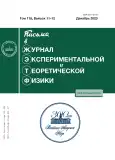Binary Coding by Microwave Pulses on the Transverse Magnetization of the Tetracyanoethylene Radical
- Authors: Zaripov R.B.1, Khayrutdinov I.T.1
-
Affiliations:
- Zavoisky Physical-Technical Institute, FRC Kazan Scientific Center, Russian Academy of Sciences
- Issue: Vol 118, No 11-12 (12) (2023)
- Pages: 826-833
- Section: Articles
- URL: https://journals.rcsi.science/0370-274X/article/view/246991
- DOI: https://doi.org/10.31857/S1234567823230064
- EDN: https://elibrary.ru/MSOZFY
- ID: 246991
Cite item
Full Text
Abstract
The possibility of coding the response of the electron–nuclear system of the tetracyanoethylene radical under microwave pulse irradiation in combination with a pulsed magnetic field gradient in the nanosecond timescale by a binary code is demonstrated. To this end, the tetracyanoethylene radical, which has a well-resolved equidistant electron paramagnetic resonance spectrum due to the interaction of the electron with equivalent magnetic nuclei, is used. The aim is to demonstrate the possibility of implementing this procedure physically rather than to encode the longest possible sequence.
About the authors
R. B. Zaripov
Zavoisky Physical-Technical Institute, FRC Kazan Scientific Center, Russian Academy of Sciences
Email: semak-olic@mail.ru
420029, Kazan, Russia
I. T. Khayrutdinov
Zavoisky Physical-Technical Institute, FRC Kazan Scientific Center, Russian Academy of Sciences
Author for correspondence.
Email: semak-olic@mail.ru
420029, Kazan, Russia
References
- Y. A. Kharlamova, N. M. Arslanov, and S. A. Moiseev, Bulletin of the Russian Academy of Sciences: Physics 86(12), 1507 (2022).
- B. I. Bantysh, K. G. Katamadze, Y. I. Bogdanov, R. V. Urmancheev, and S. A. Moiseev, JETP Lett. 116(1), 29 (2022).
- M. M. Minnegaliev, K. I. Gerasimov, T. N. Sabirov, R. V. Urmancheev, and S. A. Moiseev, JETP Lett. 115(12), 720 (2022).
- J. Chiaverini, J. Britton, D. Leibfried, E. Knill, M. D. Barrett, R. B. Blakestad, W. M. Itano, J. D. Jost, C. Langer, R. Ozeri, T. Schaetz, and D. J. Wineland, Science 308(5724), 997 (2005).
- D. P. Divincenzo, G. Burkhard, D. Loss, and E. V. Sukhorukov, Quantum Mesoscopic Phenomena and Mesoscopic Devices in Microelectronics 559, 399 (1999).
- S. I. Protasov, R. B. Zaripov, I. T. Khairutdinov, and K. M. Salikhov, Appl. Magn. Res. 53, 1539 (2022).
- A. Morello, J. J. Pla, F. A. Zwanenburg et al. (Collaboration), Nature 467, 687 (2010).
- Z. Hu, B. Dong, Z. Liu, J. J. Liu, J. Su, C. Yu, J. Xiong, D. Shi, Y. Wang, B. W. Wang, A. Ardavan, Z. Shi, S. D. Jiang, and S. Gao, J. Am. Chem. Soc. 140(3), 1123 (2018).
- M. Yu. Volkov and K. M. Salikhov, Applied Magnetic Resonance 41(2), 145 (2011).
- K. I. Gerasimov, S. A. Moiseev, V. I. Morosov, and R. B. Zaripov, Phys. Rev. A 90(4), 042306 (2014).
- K. I. Gerasimov, S. A. Moiseev, and R. B. Zaripov, Appl. Magn. Reson. 48, 795 (2017).
- В. Н. Пармон, Г. М. Жидомиров, А. И. Кокорин, Стабильные бирадикалы, Наука, М. (1980).
- К. М. Салихов, А. Г. Семенов, Ю. Д. Цветков, Электронное спиновое эхо и его применение, Наука, Сибирское отделение, Новосибирск (1976).
Supplementary files










